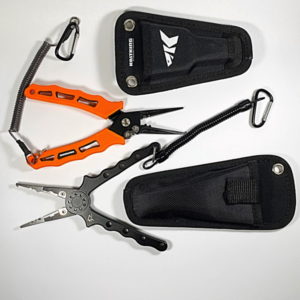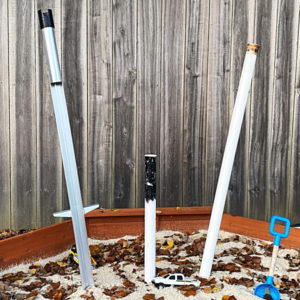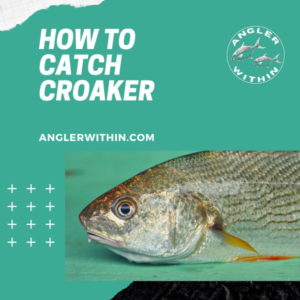If you want to catch sharks from the beach, particularly in the 4-7 foot range, you came to the right place. It’s one thing to have such a fish pick up your bait and make a run, but it’s an entirely different deal to actually land it.
Not only do you need to know how to target medium sized sharks, you need some knowledge about the various skills and equipment required to close the deal in a safe and ethical manner. Bait, rod, reel, line and leader selection are all keys to your success. This article breaks down each of the above considerations, and more, in an easy to understand way.
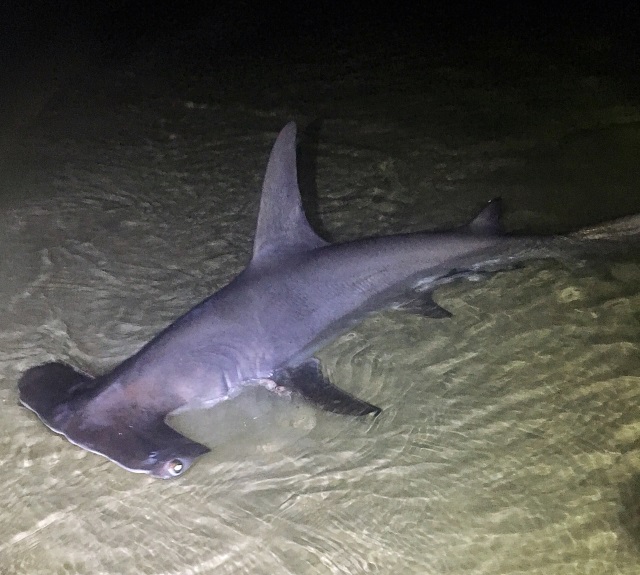
My own desire to catch sharks actually originated from a completely different species. I went on a chartered fishing trip, where we were dropping large live baits for amberjack. Prior to that, I had never actually targeted a truly big fish. After getting just a small taste of what a powerful fish feels like, I craved for more.
Taking regular chartered trips wasn’t an option, nor was buying a boat. So, I turned to the next best thing – the beach. I quickly learned that not only was it possible to catch sharks from the beach, but with perseverance, and minor equipment upgrades, it’s actually quite possible to catch large sharks from shore!
This detailed guide to shark fishing will show you exactly how you can catch sharks in the medium sized range (4-7 foot). The reason I target sharks in this range, is because they doesn’t necessarily require expensive, specialized equipment. And, I can generally handle a solo release of a shark this size. It’s, of course, always better to have at least a 2 man team for safety reasons.
In contrast, if you want to catch sharks larger than 7 foot, you will need very powerful reels, and you will need to kayak out your baits. Additionally, you will likely want to involve 1 or 2 team members. All of this adds to the expense and hassle of the sport, which is why we aren’t going to focus on that here.
Another reason you might want to cast baits for sharks, is that surf conditions don’t always allow you to kayak a bait out safely. The methods discussed here will let you get in the game without having to kayak baits.
Most people should probably start with surf casting for medium sized sharks anyway, before working up to a beast over 7 foot.
Where To Catch Sharks
You can pretty much catch sharks on any beach, but some places are better than others. An ideal beach for casting to sharks is obviously one where deeper water is within casting distance, or at least close by. I like to avoid beaches where shallow sandbars stretch out for long distances from shore.
Google Earth, combined with NOAA charts help give you a good idea of the depths of water in your area, and how to access the best looking areas.
As an example, here is the NOAA link for Pensacola Bay Florida. As shown below, some areas will clearly have deeper water closer to shore. I think you increase your odds by focusing on those areas closest to deep water.
I like to look at these NOAA charts to identify what I think are good areas, then I use Google Earth to seek out the closest access points to those areas. Also, I’m not scared to try inshore areas that have deep water access points near the pass. At certain times of the year, there are plenty of sharks roaming inside these bays.
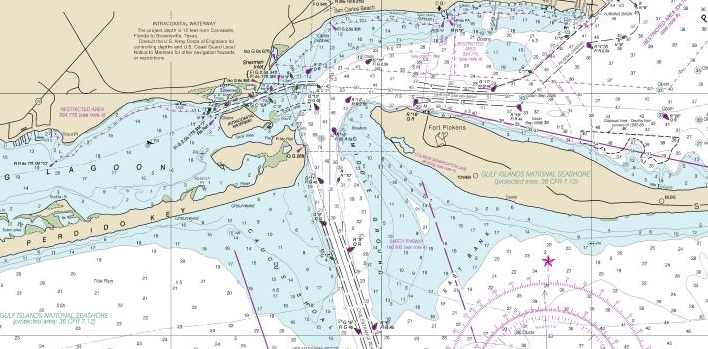
When casting baits out, you want to cast beyond the sandbar(s), if possible, even if you have to wade a distance out to do it. If that isn’t possible, fish inside the gut(s) between the sandbars and the beach. Just be sure not to leave your bait sitting up on top of a sandbar. You can usually avoid this, even at night, by reading where the waves are crashing on the bar. You are much more likely to hook something of size inside a gut, rather than up on top of a sandbar.
Best Times To Catch Sharks
Depending on where you are fishing, there will be different species available to you at different times of the year. I won’t try to nail down the best fishing in your specific area, as there is just too much geographic variation. But, generally speaking, spring is an excellent time to catch sharks, and you have a better chance at larger species during that time. With that said, there will be sharks available for you to catch year round, especially spring through fall.
You may have to search out local knowledge to really drill down to what sharking opportunities you have in your area. But, anytime you have a schooling species of fish migrating through, such as mullet or spanish mackerel, there should be sharks following close behind.
Note: It is illegal to target sharks from the beach in Alabama. And, Florida now requires you to have a FREE shark permit. So, know your regulations before setting out.
Best Baits To Catch Sharks

Your primary key to success is going to be bait. Bait is king. Typically, the best baits for sharks are whatever oily and bloody fish is prevalent in the area where you are targeting them. Some examples are jacks, stingrays, bonita, mackerel, and ladyfish. That’s not to say other baits won’t work, because they will. Even a pinfish, or a hardhead catfish with the fins broken off will work in a pinch.
Luckily, many of these species are easily obtained from the surf. That is the best bait – whatever you can pull straight out of the surf, and put onto your shark hook. Fresh bait is the best bait, and any time you can get fresh bait, it’s usually preferred over frozen options.
But, you can’t necessarily count on catching bait on your shark trip. So, be prepared to obtain at least some of your bait ahead of time. Either catch it yourself, and put it on ice, or purchases frozen baits. I typically buy frozen bonita as my backup plan. You need something to get you started, in case you have trouble finding bait. Another option is to hit up the local docks where charter boats come in at the end of the day, and see if you can obtain some free fish carcasses.
- Stingray
- Ladyfish (Skipjack)
- Mackerel
- Bonita
- Jack crevalle
- Amberjack
- Bluefish
- Blue Runners
- Mullet
What I generally do is go surf fishing at sunrise, and I may, or may not cast out a big rod. But, the main goal is to collect shark bait while I’m fishing for other species such as pompano and whiting. I’ll often catch ladyfish, stingrays, bluefish, mackerel, or small jacks while surf fishing. I’ll throw these by-catches into the cooler, to be used that evening, or to be used at a later date for shark fishing.
If I’m not happy with the baits I have caught, I’ll swing by the bait shop to get frozen bonita. This is the backup plan, in case I continue to struggle finding bait that evening.
Bait Size
Since we need to be able to cast our baits out, we can’t get too crazy with the size here. Very large baits are extremely difficult to cast. When fishing with chunks of bait, you want something from half the size of your fist to the full size of your fist. Fish heads are good, as are chunks of cut up fish. Or, if you can catch a small fish, such as a hardtail jack, whiting or similar fish, about the size of your hand, that would work well as live bait. As long as it’s a size that you can cast out effectively, it will work great.
If you are going to lean one way or another, go bigger. Bigger baits stand up longer to crabs and other bait stealers lurking on the bottom, and they don’t get washed out (lose their flavor) as quickly.
Keep Your Shark Bait Fresh
Obtaining the freshest bait possible, and keeping that bait fresh will boost your chances of regular success.
Once you have caught bait, either use it immediately, or put it on ice immediately. When I say on ice, I mean ice, not a watery slush. If you submerge your baits in water, they are going to get washed out and lose some of their effectiveness before you even get to use them.
I know it can be very challenging to prevent a cooler of ice from becoming slushy on a hot day. So, either keep your baits inside plastic bags, and drop the bags into the icy water. Or, keep diligently draining the water, and try to keep your baits up on top, and out of the water.
Main Line Options
I prefer using spinning reels when casting baits out for sharks. Therefore, I like to use braid, as it resolves the line capacity issue with most spinning reels. You want to be able to have about 300 yards of line and with it’s much smaller diameter, braid will get you there. I prefer 65lb power pro braid. Monofilament can work for you on certain reels with enough line capacity – about 30 pound will do the job in the hands of an experienced angler.
Braid does have some downsides you should be aware of.
It can be a challenge to cast a spinning reel spooled with braid, when you are tossing heavy payloads. The small diameter of the braid tends to want to cut into your finger as you cast. To handle this, you can use a glove, medical tape wrapped around your finger, or you could use a casting aid (shown below). I have not tried one yet, but I’m planning to give it a try on my next shark trip.
Leaders For Mid-Sized Sharks
Regardless of what main line option you choose, you have to use some sort of leader to have much of a chance at landing a shark. It should be clear by now, we are only concerned with castable shark leaders. We aren’t concerned with those big string trimmer cord sized leaders that are impossible to cast. Below are the 2 leader options that I use most often. One has a sliding sinker sleeve holding a Sputnik sinker (spider weight). The other uses a sliding swivel, with a short length of mono holding a more traditional pyramid weight. My preference is to tie these 6 foot overall leaders to my braided main line using an FG knot.
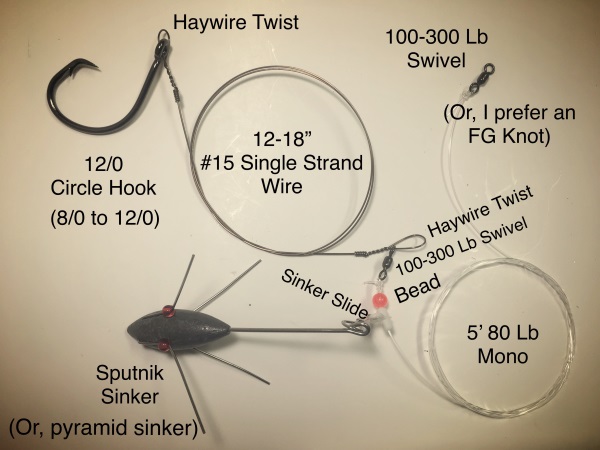
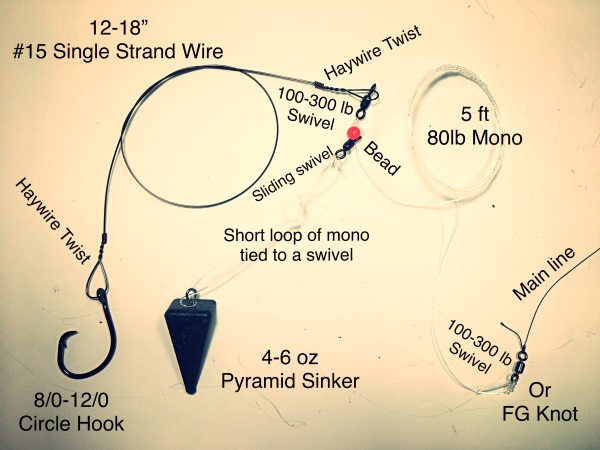
I’ll discuss all the components of a castable shark leader, beginning with the hook, and working my way towards the main line
- 9/0 - 13/0 Circle Hook
- 12-24” of wire or cable for the bite leader portion
- Barrel Swivel
- Bead
- Sliding weight
- A section of monofilament shock leader
- A swivel or FG knot for the connection to the main line
Hooks
The business end of my shark leaders has a large and very strong non-offset non-stainless circle hook. It should be noted that, by law, you must have a non-offset non-stainless circle hook in Florida. Even if that were not the case, this would be my preference for sharks.
I like anywhere from a 8/0 to 13/0 sized circle hooks. Your hook should somewhat match the size of your bait. A smaller piece of bait can be used with an 8/0, whereas you might use up to a 13/0 for a large piece of bait. Just make sure you don’t bury your hook into the bait. The hook point needs to be exposed, and the hook should be inserted shallow enough into the bait that it can rip free when you set the hook.
The hook that I specifically use is the Eagle Claw Circle Sea L2004. Years ago, I took the online recommendation from Josh at BlacktipH, and stuck with it. That hook seems to catch sharks just fine, so I keep using it. Another popular option for this application is the Mustad Demon Perfect Circle, but there are many other fine options.
Wire, Or Cable, Bite Portion Of The Leader
Most any shark leader is going to have a wire or cable section connected directly to the hook. How long you make that section is up to you. I like this bottom section to be about 12” of #15 single strand wire, which is normally plenty long for the size sharks I’m after.
The reason I like the bottom portion of a castable shark leader so short, is because I want the weight as close to the hook as possible during the cast. This shortened distance helps prevent your leader from twirling in the air. This helicoptering effect will limit the distance of your casts.
Attach one end of the #15 wire to your circle hook using a haywire twist, and the other end to a 100-300 pound swivel by doing the same. It should look something like this.
Monofilament Shock Leader
When using braid, you are going to want a strong mono leader section between the braided main line and the wire portion of the leader. This serves several purposes. It helps prevent break offs during the cast, since it absorbs some of the shock. You will also be glad you have something to grab onto when you are trying to beach a shark. Without it, the braid could slice your hands as the shark thrashes around. But, most importantly, the mono section of the leader provides protection from the sharks skin and tail once he is hooked. A sharks skin is like sandpaper and will cut through braided line.
- Absorbs some of the shock during the cast, helping to prevent breakoffs
- Provides something to hold onto when beaching a shark
- Protection of your line from the sharks sandpaper-like skin
- Protection from the sharks tail whipping during the fight
An 80 pound section of mono works great for this part of the leader. I find it to be a good balance between being strong enough, and still being easy to tie knots with. I rarely use anything else. Simply tie this monofilament line directly to the bite leader swivel using the knot of your choice. I use an improved clinch knot.
Beads
Add a plastic bead between the connection to your bite leader, and the sliding sinker to be added next.. Just get some cheap plastic beads that have a big enough hole that 80 pound mono will fit through.
Sliding Sinker
After sliding your bead onto the mono section of the leader, you will then add a sinker.
But, it’s tough to throw an 8 ounce sinker when combined with a hunk of bait. That takes a very powerful rod.
When i can get away with it, I use pyramid sinkers. Your shark arsenal should contain 4, 6 and even 8 ounce pyramid sinkers. However, when the tide is ripping, you may be better off switching to a sputnik or spider weight, so you don’t have to use a really heavy pyramid. It’s really tough to throw an 8 ounce sinker when combined with a hunk of bait. That takes a very powerful rod. So, my shark kit also includes 4 and 5 ounce Sputniks as well.
To attach weight’s to my mono leader, I like to use sliding sinker sleeves, or I’ll tie a length of mono to a swivel, which I then slide onto the mono leader. Both methods can be seen in the images above. Either way is fine.
Connection Between The Leader And A Braided Main Line
Now that we have our leader built, we need a way to attach it to our main line, which in my case is braid. Although we want our leader to be castable, we do still need it to be as long as the sharks we plan to target (6-7 foot). Therein lies a challenge. We would obviously have a hard time casting a 7+ foot leader with a heavy payload at the end. There are a couple different options to deal with this.
FG Knot
One option is to use an FG knot to provide a small enough connection that will pass through your rod’s guides. The FG knot is the best way to connect a braided main line to a thick mono leader. This is a very strong knot with the smallest profile possible. This allows you to reel part of your 80 pound leader through your rod guides, so that you can perform a “normal” cast.
The FG knot can be challenging at first to tie, but with some practice, it’s actually pretty easy. I inserted a good Youtube video below, showing clearly how to tie this knot.
Other Knots
If you don’t like the idea of winding and casting a knot through your rod guides, you can get by with a 6 foot leader and casting it out, using a 12 foot or longer rod. This takes some skill, but is doable, and I use this method about half the time. Just reel the knot, or swivel, as close to the rod tip as possible, and cast away. With a 12-13 foot rod, you can even wade out, and still be able to cast a 5 or 6 foot leader.
A Recap Summary Of My Shark Leader Preferences
So, my preference is to use a 6 foot total length leader attached to the mainline with an FG knot. Beginning at the hook end, you need a 8/0 – 12/0 non-offset circle hook to match the size bait you will be using. The hook will be attached to a 12-18” length of single strand wire using a haywire twist. Attach the other end of the wire to a 100-300lb barrel swivel – you can go bigger, but don’t go smaller. Tie 5 to 6 feet of 80-100lb monofilament to the swivel, and slide a plastic bead onto the mono section. Next, add a sinker slide to the setup, and tie the mono to your mainline using an FG knot. Then, all you have to do is add your sinker to the sinker slide once you are set up at the beach.
Best Shark Reels For Casting Baits
Qualities Of A Good Castable Shark Fishing Reel
- Powerful Drag System
- High Line Capacity
- Strong Frame And Components
- Reputation
When it comes to shark reels, you not only want them to be able to handle the fish, but you also need it to get the shark in without completely exhausting it. The fish will need reserve energy to be able to swim away and survive. This applies whether, or not, you plan to keep the shark, because you won’t know what species you have until you land it.
While it’s true that some anglers prefer conventional style reels when casting from the beach, I think most people are better off with a beefy spinning reel. Generally speaking, spinning reels are easier to manage on the beach, especially when dealing with darkness. If you feel you have the skills to effectively use a conventional reel, go for it. They can work great, and give you more casting distance when in the right hands.
The primary qualities you want in a castable shark reel are a high line capacity, a powerful drag system, a great reputation, and a strong frame. These are not qualities you will find in just any spinning reels.
One of the reels I use is an older Shimano Spheros 18000, which the manufacturer claims has 44 pounds of max drag, and a line capacity of 380 yards of 20lb mono. This equates to over 400 yards of 65 pound braid. This is the kind of reel you will be looking for.
I love my old Spheros, and it works great, but I plan to add another spinning rig to my arsenal soon, and it won’t be a Spheros. It seems like the newer Spheros’ don’t have the reputation that the older ones did.
The 4 reels listed below are all contenders for my next shark fishing reel.
- Penn Spinfisher V 10500
- Daiwa BG8000
- Penn Slammer
- Fin Nor Offshore 9500
I have a friend that uses a Penn Spinfisher V 10500, so I know that one will get the job done.
Both the Penn Slammer and Daiwa BG reels also seem to have outstanding reputations, but they each come in at very different price points. I’m not sure I personally want to spend what the Slammers cost.
Finally, there is the Fin Nor Offshore 9500. The drag on the Fin Nor’s is amazing, and these seem to be one of the best value reels on the market for this application.
Below are links to the 4 that I’m considering for my next shark reel, and I’m finding it to be a tough decision. You can probably come up with other good options, but these should give you an idea of what you are looking for.
Best Shark Rods For Casting Baits
Rods for this type of fishing need to be 10-13 feet long, and very powerful. You will occasionally hear the phrase “heaver” or “8 and bait” (“8NBait”) thrown around in the surf fishing world. This means a rod capable of casting a sinker weighing 8 ounces plus a big chunk of bait, and this ideally what you want.
Besides casting a heavy payload, a powerful rod also helps you to take full advantage of the powerful drag of your shark reel.
I have an entire article geared towards selecting a surf rod. Check it out for a detailed breakdown of all factors you should consider. At the end of that article (linked below), I list several quality rods I considered, and which one I chose for my sharking rod: How To Choose A Surf Rod
Fighting Harnesses And Belts Help You Catch Sharks
You might wonder if you really need a harness when trying to catch sharks in the 6-7 foot range. First of all, you can’t control what might pick up your bait. With a harness, you have a better shot at landing larger sharks that you may hook in to. And, a harness frees you up to enjoy the fight, rather than focusing on the pain of a rod crammed into your crotch. The image below is a link to the harness that I have.
Bite Indicators
Although a reel with a clicker is nice, it definitely isn’t necessary. What I do is attach a glowstick to the tip of my rod using clear, waterproof medical tape, which I get from Wal-Mart. Some glow sticks you buy come with little strings to tie them on to things. DO NOT use those strings to tie the glow stick to your rod. The loose strings can get tangled with your main line and hook eyes, and cause you to have break offs when a big fish makes a run. Don’t ask me how I know.
I don’t like bells, or anything like that. If it’s daytime, I just keep a close eye on my rods. If it’s night time, I always use glow sticks.
Setting Up On The Beach
Putting it all together goes something like this.
When setting out to catch sharks, I like to arrive at the beach an hour or two before sunset and get set up in the daylight. Setting up in the daylight is more enjoyable to me. Arriving at this time also gives you a great opportunity to catch fresh bait that should be actively feeding during the last hour of the day.
You can catch sharks at any time of the day or night, but shortly before sunset up to 11PM seems to be the most productive window for me. But, the main reasons I usually opt to catch sharks at night is twofold. First, you avoid most of the beach goers, and second, sharks are more likely to venture into the shallows during low light conditions, where I can reach them with my spinning outfit.
When I first arrive to the spot, I will take my rubber mallet and firmly place 2 or 3 sand spikes near the waters’ edge anywhere from 10 to 20 yards apart. After placing my pre-rigged rods into the holders, I attach whatever size weights I think I’ll need, knowing that I may need to adjust later, depending on current.
Next, I locate and arrange all my critical gear so that I know how to get to it quickly. I don’t like to cast out a bait until I’m comfortable with the location of my gear. You don’t want to be searching inside bags for your de-hooking equipment while your shark is thrashing around at the waters’ edge.
I don’t usually attach my glow sticks until about 30 minutes before dark, but I do so while there is still at least some daylight. This is another task that is easier during daytime, and those sticks last a long time, so there isn’t much risk of them running dim on you.
Once I’m comfortable with my setup, I like to go ahead and use some of the bait that I brought along to go ahead and cast out a big rod. I set the drag fairly loose, just tight enough to keep slack out of the line. Once I have a shark rod soaking, I begin to fish with my smaller rod for bait.
When you place your rods, you will want to fan the casts slightly away from each other. The only thing to do now is to crack open a cold one and wait.
Don’t wait much more than an hour before checking your bait, as by that time the crabs may have picked it clean.

Hooking And Landing A Shark
When your bait gets picked up by a sizable fish, you will typically know it. Your line should start to peel off the reel. It might come off slow and steady, or it might come off fast. If at night, your glow stick will clearly be bouncing in the darkness.
Be patient, and let the fish run with the bait for 8-10 seconds before applying any pressure at all It’s important to note that you should not jerk your rod tip when fishing with circle hooks, as you will likely yank the hook out of the fishes mouth. Instead, when you feel like the fish has had enough time to eat the bait, tighten your drag down some, and apply firm and steady pressure to set the circle hook, hopefully in the corner of the mouth. Once you feel like the hook is likely set in the corner of the fishes mouth, then you can give your rod some strong pumps to really drive the hook home.
If, all the sudden, you feel nothing after applying pressure, it could be that the shark managed to take your bait without getting the hook inside his mouth. If that happens, I like to leave the bait out for a minute or two, to make sure he didn’t just drop the bait, as he might pick it back up. But, don’t wait too long, or you may be needlessly fishing with a bare hook.
When the time comes and you actually have a shark hooked up, you will want to let him have his initial run before beginning the fight. Be patient, don’t reel against the drag, and wait for him to slow down some. Once he slows, that’s the time to get going. If the shark makes a run toward the beach, try to keep up with him the best you can.
It’s very helpful to have some fishing buddies around to help with lights, leader handling and camera work. If fishing solo, a good headlamp is a must, and you will have to work very fast if you want to land the shark, get a photo, remove the hook, and release it safely and quickly. I have often used nosy beach goers to hold my leader while I freed the hook. Bystanders are usually happy to lend a hand.When in doubt, go straight to the bolt cutters to cut the hook out, or cut the leader as close to the hook as possible.
Be sure to leave any shark you don’t plan to keep in the water at all times. Ideally, the gills should be partially or fully submerged as you handle the shark. In Florida, it’s now the law that you must not drag non-keeper sharks onto the sand to take photos.
To add more meaning to your shark fishing ventures, you might consider joining the shark tagging program. For details about that you can visit the NOAA site here: Shark Tagging Program
Additional Gear
Following is a list of additional gear I like to bring on my shark fishing trips. Headlamps are an absolute must if fishing at night. I also like to have a spotlight so that I can get a really good look at my catch once I get it to the beach. They are also helpful to see where the waves are breaking on the sandbar.
- Headlamp(s)
- Spotlight
- Bug Repellent
- Sunglasses
- Sunscreen
- Hat
- Camera
- Extra terminal tackle and leaders
- Cutters for leader and hook
- Rod holders (sand spikes)
- Folding chair
- Drinks and snacks
- Extra rod and reel for bait
- Some bait to use to catch bait
- First aid kit
- Rubber mallet for sand spikes
- Cooler with ice
- Surf cart or backpack
- Bait knife
- Pliers
- Sunscreen
- Glow sticks
- Waterproof medical tape
- Measuring tape
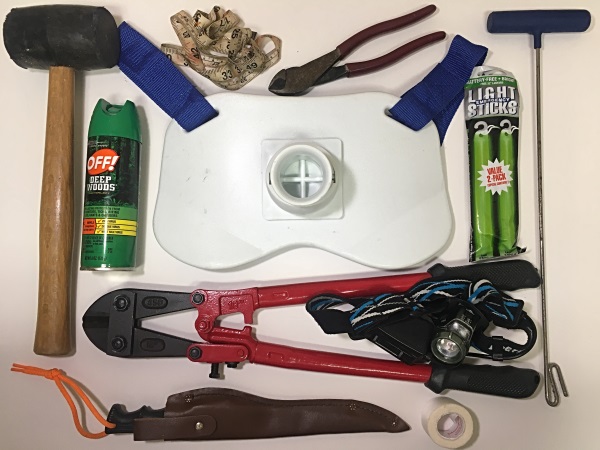
Potential By Catches When Trying To Catch Sharks From The Beach
There is a chance you could hook into any of the following species when targeting sharks. Any of these would be a pretty good consolation prize!
- Bull Reds
- Black Drum
- Tarpon
- Jack Crevalle
- Cobia
Conclusion
I believe everyone who wishes to catch sharks from the beach, should first get their feet wet with 6 footers before trying to ethically tangle with a giant. The info above should, at least, help point you in the right direction.
I wish you success on this addictive venture!
Augustus Clay
Note: As of July 2019, you need a free shark permit to go shark fishing in Florida. If you plan to target sharks in Florida, check out my Florida Shark Fishing Permit article.







